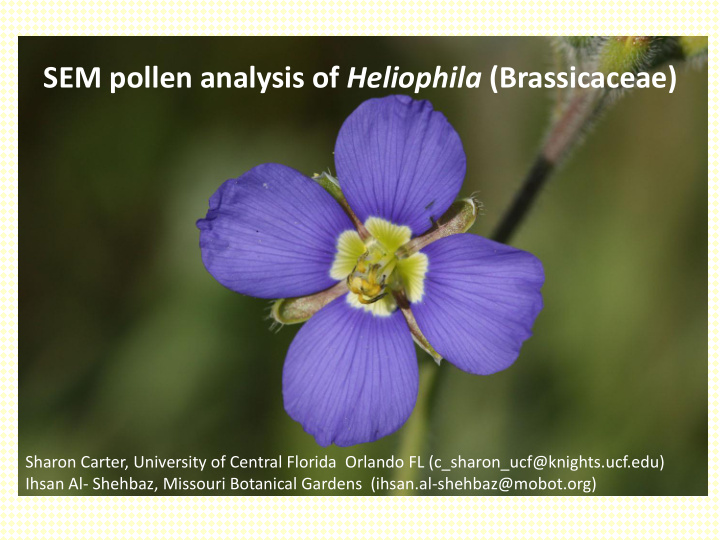



SEM pollen analysis of Heliophila (Brassicaceae) Sharon Carter, University of Central Florida Orlando FL (c_sharon_ucf@knights.ucf.edu) Ihsan Al- Shehbaz, Missouri Botanical Gardens (ihsan.al-shehbaz@mobot.org)
Introduction Brassicaceae – Mustard Family - 320 genera - 3660 species Cruciform corolla - Easily identifiable Tetradynamous stamens Capsular fruits
Draba verna Stenopetalon Floral Iberis Diversity Schizopetalon walkeri Streptanthus Ornithocarpa torulosa glandulosus Lepidium oleraceum Zerdana Lepidium lasiophyllum anchonioides Stanleya pinnata
Heliophila -Endemic to South Africa, especially the Cape Region -88 species -High variability in fruit morphology Springbok - Fynbos eco-region
9 5 25 8 7 3 10 4 12 2 26 FRUIT DIVERSITY 27 1 20 6 13 Scale = 1 cm 29 14 28 11 30 15 21 23 22 18 17 16 19 24
Heliophila fruits 1. H. cornuta 21. H. eximia 2. H. elongata 22. H. concatenata 3. H. cinerea 23. H. crithmifolia 4. H. callosa 24. H. scandens 5. H. africana 25. H. hurkana [ formerly Cycloptychis marlothii] 6. H. scoparia 26. H. maraisiana 7. H. pendula [ formerly Cycloptychis virgata] 8. H. descurva 27. H. monosperma 9. H. variabilis [formerly Schlechtertia capensis ] 28. H. juncea [formerly 10. H. latisiliqua Brachycarpaea juncea ] 11. H. brachycarpa 29. H. polygaloides 12. H. patens [formerly Silicularia polygaloides ] 30. H. suborbicularis 13. H. diffusa [formerly Thlaspaeocarpa capensis ] 14. H. ephemera 15. H. pusilla 16. H. collina 17. H. arenaria 19. H. amplexicaulis 20. H. cornellsbergia
Objective Determine pollen ornamentation in the genus Heliophila using SEM (scanning electron microscopy)
Why Study Pollen?
Pollen Tricolpate 96.2% of Brassicaceae Streptanthus carinatus Pollen polycolpate Tribe Physarieae (3.8% of family) Physaria gordonii
Methods - Mount pollen from anthers to SEM stubs for all 62 taxa of Heliophila - Sputter Coat for 2 min at 35 mAmps - View using SEM - Measure polar, equatorial, and colpi length and determine the P/E ratio
Results Cladogram from Lysak et al. 2012 (Taxon 61, in press) Spinulose A Reticulate C B
Spinulose - 41 species H. pusilla H. coronopifolia H. linearis H. collina
Reticulate: Coarse and Fine - 17 Species H. glauca H. brachycarpa H. dregeana H. macrosperma
Spinulose with fine reticulation - 4 Species H. arenosa H. namaquana H. suavissima H. suborbicularis
Conclusion Pollen ornamentation types Major -Reticulate (coarse and fine): Heliophila Clade B -Spinulose: Heliophila Clades A,C Minor -Spinulose with fine reticulation: Heliophila arenosa and H. namaquana (Clade A) Heliophila suborbicularis and H. suavissima (Clade C)
Future Work -Use light microscopy and transmission electron microscopy to analyze the anatomic structural basis of the pollen wall -Determine if the Spinulose type is present in other genera of Brassicaceae -Study the flower pollinators to understand if the Spinulose type has possible adaptive pollination values
Acknowledgments I would like to thank Dr. Ihsan Al-Shehbaz, REU Coordinators Dr. Sandra Arango-Caro and Dr. David Bogler, the Missouri Botanical Gardens (MBG) and the National Science Foundation (NSF). Their support and encouragement made this project possible. I would also like to thank Dr. Martin Lysak for providing the cladogram of Heliophila .
Recommend
More recommend